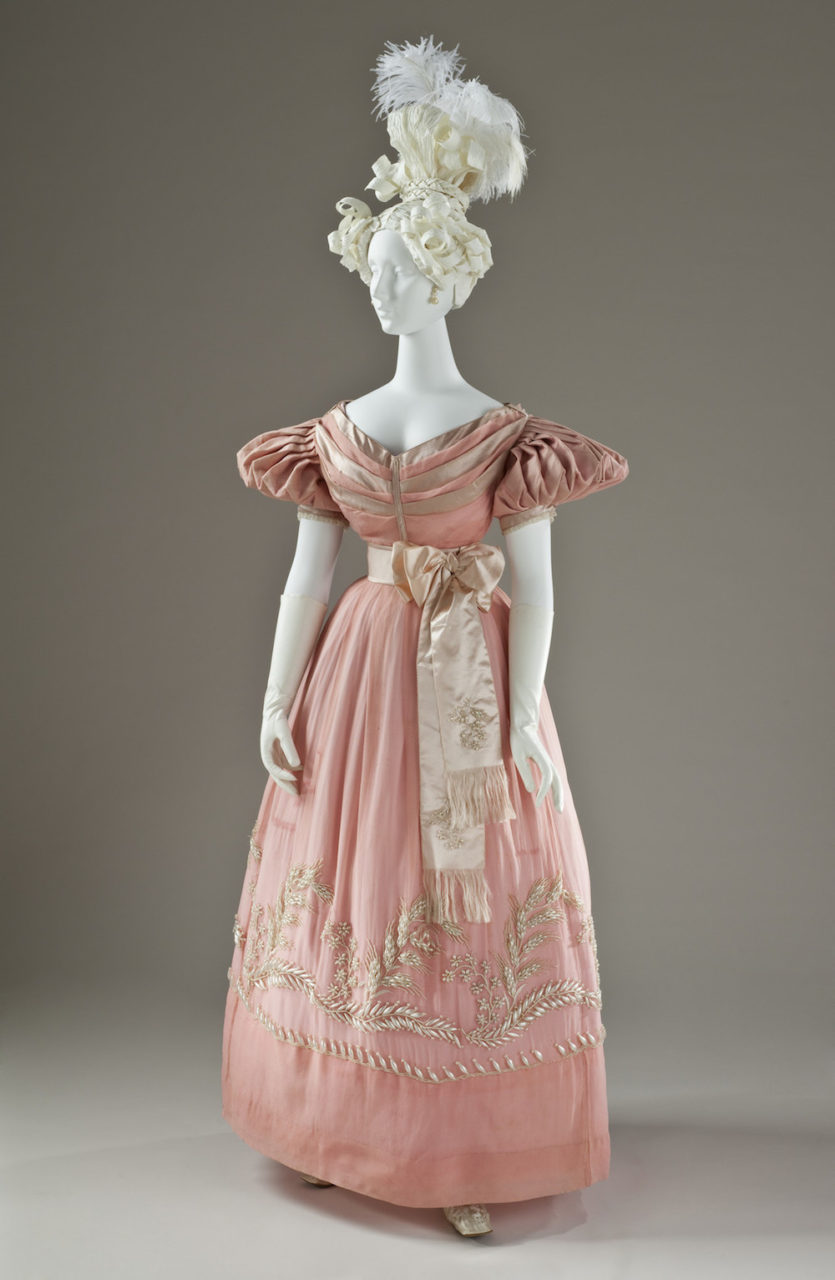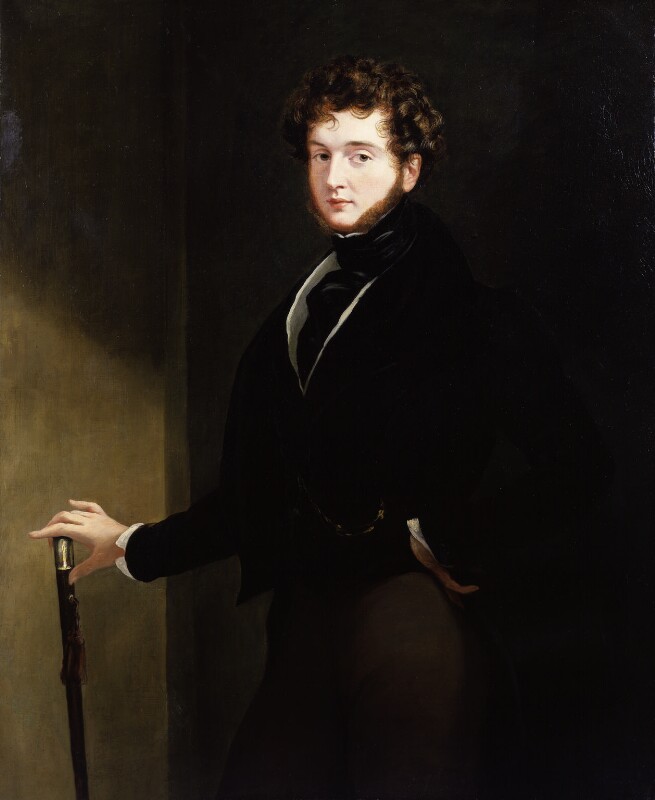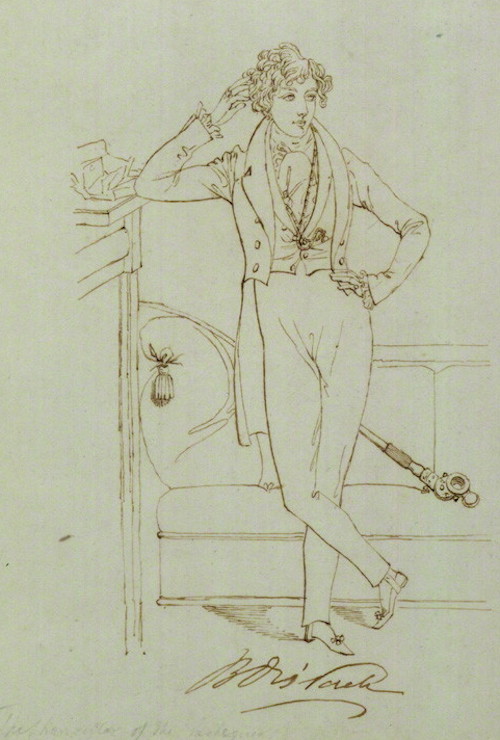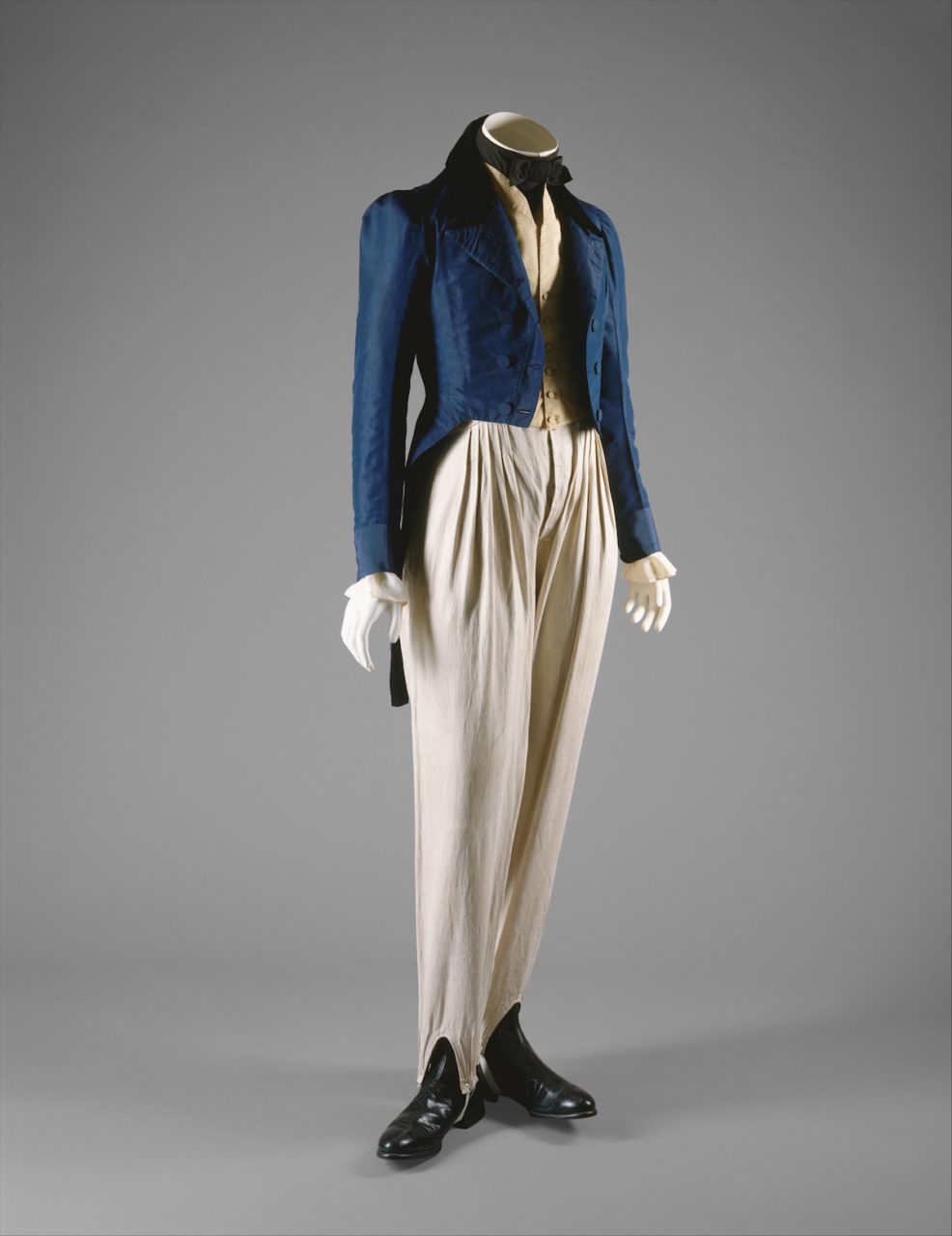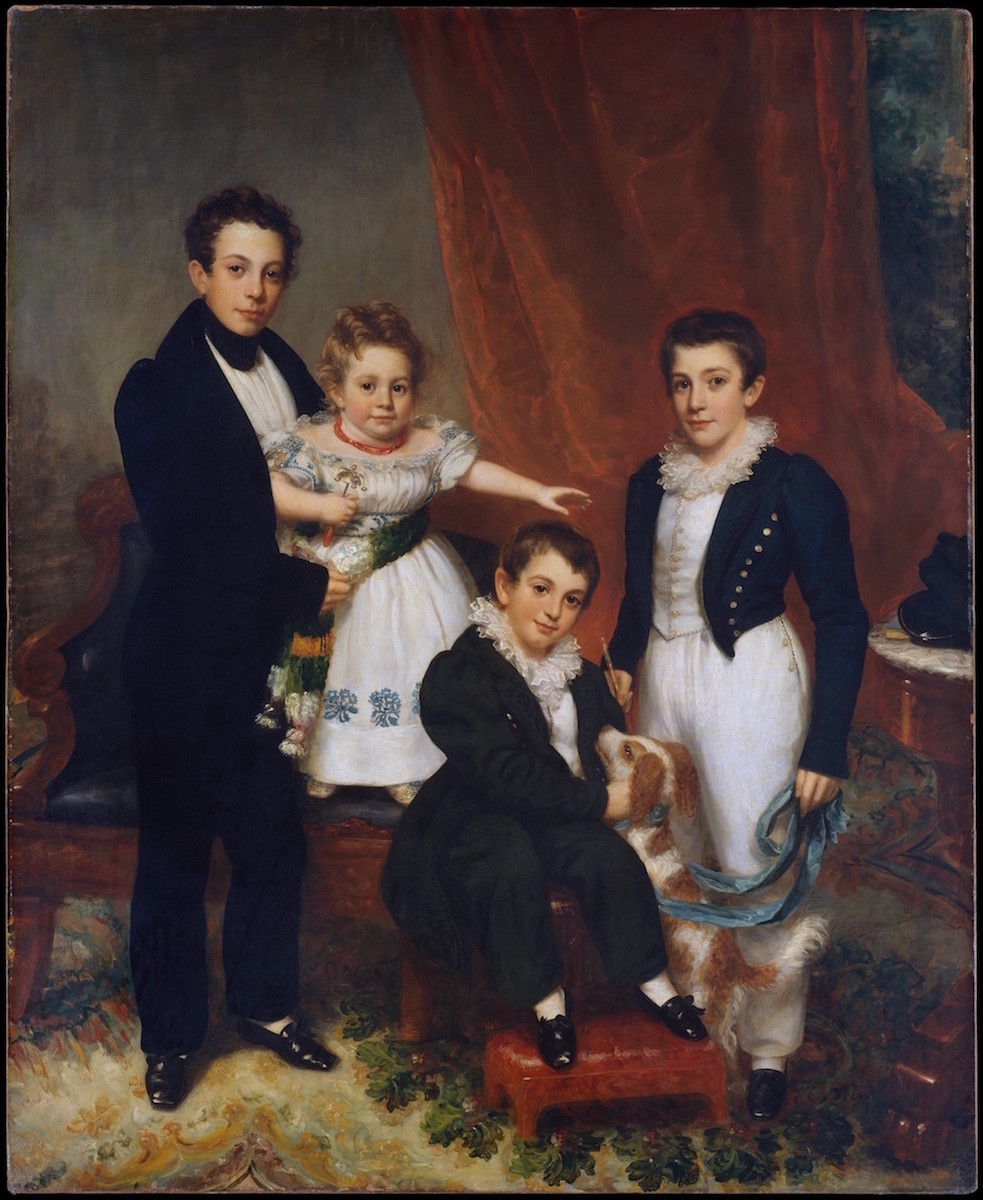OVERVIEW
1830s fashion was dramatic and overwhelming, marked by huge sleeves and hats, reflecting the Romantic movement. Extravagant dandies led the fashion world. After 1836, the exuberance that had defined fashion since the 1820s collapsed into a drooping sentimentality.
Womenswear
Womenswear during the 1830s was exuberant and dramatic, tied closely to Romanticism, which influenced all aspects of society during the first half of the nineteenth century (Fig. 1). Romanticism emphasized emotion, the beauty of nature, and individualism. For women, there was a general sentimentality about the domestic sphere and the importance of a moral center at home (Bassett 16-17). Perhaps the element of Romanticism that was most clearly at play in fashion was the tendency to look backward to history for inspiration (Cunnington 107; Tortora 328). Historicism pervaded 1830s style, especially interpretations of the seventeenth century in the wide collars, puffed sleeves, and curled hairstyles (Bassett 26-29). Lynne Zacek Bassett noted in Gothic to Goth: Romantic Era Fashion and Its Legacy:
“The Romantic spirit was sometimes contradictory, simultaneously embracing idylls and terror, flamboyance and modesty, freedom and crushing restraint.” (16)
That description feels apt for the 1830s, a decade that began with fashions overwhelmingly bold, but ended with a style that had collapsed into a drooping sentimentality. The silhouette of womenswear abruptly shifted in 1836, and the fashionable woman was no longer one of ebullient energy, but a mild, modest woman who eschewed brash forms (Fig. 2) (Cunnington 105). This shift towards modesty was personified by the ascension of Queen Victoria to the throne in 1837. Despite her young age, Victoria preferred an understated, simpler style, and was cautious regarding new fashions. Her quiet modesty, piety, and maternal devotion to her family represented the ideal Romantic woman in many ways (Bassett 30; Byrde 46).
As previously mentioned, the silhouette of the 1830s shifted in 1836, meaning that women’s fashion must be divided into two silhouettes. The first began in the mid-1820s, and was fully realized by 1830 (Fig. 3). Fashion historian C.W. Cunnington summarized it well:
“The flood of romance which had risen to such a height by the end of the ‘20s reached a culmination, so far as fashions went, in the year 1830, when extraordinary attention was lavished on the upper half of the dress and the sleeves. Innumerable… types of bodice appeared… In addition, there were at least a dozen different patterns of sleeve for day use; and when it is recalled that the hats were more startling in color and size than the dresses it can easily be understood that the total effect was overwhelming, especially as the woman of fashion wore them all with an air of perfect assurance; the mode was not intended to be anything but ravishing and arresting; a spirit of conquest dominated the designs.” (105)
The silhouette consisted of a nipped waist that fell just above the natural waistline, giving a short-waisted effect, and wide sleeves and skirts that ended just above the ankle (Fig. 4) (Byrde 41). Overall, fashion emphasized and highlighted an expansive width (Ashelford 191). The sleeve was, by far, the most significant element of fashion. Gigot or leg-o-mutton sleeves reached an apex in size between 1830 and 1833, and many varieties appeared (Byrde 39; Johnston 76). Designs ranged from the standard gigot which was full to the wrist, to the demi-gigot which was fitted from the elbow, to the fanciful “à la giraffe” design in which fullness was banded down at intervals creating a series of puffs (Tortora 333; Foster 56; Byrde 39-40).
Fig. 1 - François-Joseph Navez (Belgian, 1787-1869). Théodore Joseph Jonet and his two daughters, 1832. Oil on canvas; 145 × 120 cm (57.1 × 47.2 in). Private Collection. Source: Wikimedia Commons
Fig. 2 - Henry Inman (American, 1801-1846). Georgianna Buckram and Her Mother (Anna Traphagen Buckram), 1839. Oil on canvas; 86.68 x 68.9 cm (34 1/8 x 27 1/8 in). Boston: Museum of Fine Arts, 19.1370. Bequest of Georgianna Buckham Wright. Source: Museum of Fine Arts
Fig. 3 - Artist unknown. La Belle Assemblee: French Fashions, June 1830. Los Angeles: Los Angeles Public Library, rbc1242. Source: Los Angeles Public Library
By 1836, the floating buoyancy of women’s fashions abruptly collapsed; the sleeve simply could not get any bigger and suddenly, women’s clothing took on a drooping, sentimental quality (Johnston 76; Byrde 38). The waistline and hem lengthened throughout the rest of the decade. The all-important sleeve entered a transitional phase in the late 1830s, between the enormous gigot and the tightly fitted sleeve of the 1840s. The fullness in sleeves began to shift to the lower arm, as the fullness at the top underwent a variety of treatments to control it (Byrde 46). One of the most common approaches was to gather or pleat the fullness into a tightly fitted upper arm that expanded into a dropped gigot sleeve (Fig. 5) (Johnston 172).
Fig. 4 - Designer unknown (American). Day dress, ca. 1830. English roller-printed cotton twill. Philadelphia: The Philadelphia Museum of Art, 1956-14-2. Gift of Mrs. William F. Machold, 1956. Source: The Philadelphia Museum of Art
Fig. 5 - Designer unknown (American). Day dress, ca. 1837. Spitalfields 18th century silk. Philadelphia: The Philadelphia Museum of Art, 1962-93-5. Gift of Emma Thomas, 1962. Source: The Philadelphia Museum of Art
Fig. 6 - Designer unknown (English). Corset and Sleeve Supporters, 1830-1840. Cotton. Los Angeles: Los Angeles County Museum of Art, M.63.54.7. Costume Council Fund. Source: Los Angeles County Museum of Art
Fig. 7 - Ferdinand Georg Waldmüller (Austrian, 1793-1865). Mother and Child, 1835. Berlin: Alte Nationalgalerie, AI 858. Source: Alte Nationalgalerie
The fashionable silhouette of the 1830s was created by a series of undergarments (Fig. 6). In addition to the requisite long, tightly-laced corset, the giant leg-o-mutton sleeves also necessitated support to maintain their shape (Byrde 41). Thus, women wore sleeve supports tied to their upper arm; these were usually filled with soft feathers, but they could also be reinforced with buckram or wire (Lynn 168). The widening skirt required an ever-increasing number of petticoats (Byrde 41-42). Finally, a bustle would be tied around the waist to hold out the skirt at the back. These early bustles, unlike their heavily structured descendants in the 1880s, were most often simple down-filled pads (Tortora 332).
There were several varieties of bodices during the 1830s, but all of them emphasized an upside-down triangle with all points converging at the waistline (Byrde 40). In addition to crossover designs and simple darted bodices, a particularly fashionable bodice treatment was called à la Sevigne, in which a central boned band divided horizontal folds of fabric (Fig. 7) (Cunnington 106, 108; Foster 54). In the evening, necklines lowered to almost slip off the shoulder and sleeves shortened (Fig. 8). There was a particular fashion for short puffed sleeves covered with a long transparent oversleeve of silk net or gauze (Fig. 1) (Byrde 40).
Accessories were an important element of 1830s womenswear. Daytime bodices were often completed with a wide, white pelerine that extended out over the large sleeves, further highlighting the fashionable width (Fig. 9) (Tortora 332-334). For outerwear, mantles and pelisses were worn. Shawls, ranging from kashmiris and paisleys, to airy lace and net varieties were also popular (Tarrant 13). The waistline was usually accentuated with a wide belt, completed with a bold buckle. The 1830s is notable for its lavish use of jewelry. Paired bracelets, often featuring a cameo or miniature, were stylish with gauze sleeves, for example. Long chains were worn around the waist (chatelaines), around the neck and shoulders (sautoirs), or woven into the hair and around the head (ferronnières). Brooches and elaborate drop earrings were also seen (Byrde 44-45; Tortora 340).
Fig. 8 - Designer unknown (English). Evening dress, ca. 1830. Silk, imitation-pearl glass beads. Los Angeles: Los Angeles County Museum of Art, M.2007.211.940a-b. Purchased with funds provided by Suzanne A. Saperstein and Michael and Ellen Michelson. Source: Los Angeles County Museum of Art
Fig. 9 - Jan Adam Kruseman (Dutch, 1804-1862). Portrait of Alida Christina Assink, 1833. Oil on canvas; 206 x 149 cm. Amsterdam: Rijksmuseum, SK-C-1672. On loan from the City of Amsterdam. Source: Rijksmuseum
Fig. 10 - Artist unknown. Newest Fashions for April 1831: Walking and Evening Designs, April 1831. New York: The Metropolitan Museum of Art, b17509853. Source: The Met Digital Collections
Like other elements of fashion, hair and headgear also showed a stunning variety of bold forms (Fig. 10). Hair was arranged in high chignons of loops, braids, or curls, while the hair at the front was left in rows of sausage curls or hanging in ringlets. The Apollo knot and hairstyle à la Chinoise were two such arrangements (Foster 13, 54; Tortora 334). Married women wore white, frilled day caps indoors (Fig. 2) (Ginsburg 77; Tortora 334). Both hats and bonnets, worn outdoors, had expanded greatly in width to balance the sleeves, reaching an apex in 1830, after which they gradually began to shrink in size (Cunnington 122; Byrde 45). Hats and bonnets featured a high crown and a huge, halo-like brim, and were loaded with trim. When the silhouette shifted in 1836, so did hair and hats. Hairstyles simplified; by the end of the decade, hair was usually parted in the center, and brushed smoothly over the ears into a chignon at the back. The brim of hats and bonnets moved downward into a narrow oval shape, no longer framing and highlighting the face, but concealing it (Fig. 11) (Cunnington 122). Throughout the decade, hairstyles were more elaborate in the evening, and could feature decorative combs, feathers, ribbons, and flowers woven into the arrangement (Tortora 334). Married women often wore hats in the evening; heavily trimmed turbans were the most common choice (Byrde 45).
Fig. 11 - Artist unknown. La Mode, ca. 1838. New York: The Metropolitan Museum of Art, b17509853. Source: The Met Digital Collections
Fashion Icon: Alfred, Count d’orsay (1801-1852)
Fig. 1 - Daniel Maclise (Irish, 1806-1870). Alfred, Count d'Orsay, 1830s. Lithograph; 22.5 x 14 cm (8 7/8 x 5 1/2 in). London: National Portrait Gallery, NPG D7813. Source: National Portrait Gallery
Fig. 2 - George Hayter (English, 1792-1871). Alfred, Count d'Orsay, 1839. Oil on canvas; (50 1/8 x 40 in). London: National Portrait Gallery, NPG 5061. Purchased, 1975. Source: National Portrait Gallery
Few men held such sartorial power as Alfred Guillaume Gabriel, Count d’Orsay. Born to an aristocratic family in Paris, d’Orsay dominated fashion of the 1830s and 1840s. He moved to London in 1830, alongside his patron Lady Blessington and her daughter, whom he had recently married. Their home became a gathering place for the glittering of London society, the best of the literary, political, social and artistic circles (Foulkes preface, ch. 14). Most significantly, d’Orsay styled himself as an extravagant dandy (Figs. 1-2). His dandyism was one of excess; he famously changed his gloves at least five times a day, all of a different color and scented with perfume. D’Orsay wore his coats thrown back to reveal layers of luxurious waistcoats upon which multiple gold chains were looped, and an elegant silk cravat. Notably, d’Orsay was creating a French version of dandyism, which had been an English pursuit from the days of Beau Brummell. Alice Cicolini, in her definition of dandyism, wrote:
“Unlike Brummell, however, d’Orsay’s pursuit of dandyism was a search for personal fulfillment rather than social power. Already powerful by token of birth, d’Orsay’s legacy was of dandyism as fashion plate, and he became known as the original ‘butterfly dandy.’ There was also none of Brummell’s austerity; the French imagination had already mixed dandyism with English romanticism, as evidenced by d’Orsay’s more sensual, lavish, and luxurious approach to dress.”
Beyond his clothes, d’Orsay cultivated a fashionable circle of friends, and was himself a sought-after guest (Foulkes ch. 14). He was close friends with Benjamin Disraeli and Edward Bulwer-Lytton, both men of fashion and writers on dandyism (Wikipedia; Cicolini). D’Orsay was also an amateur sketch artist and sculptor, creating portraits of the most notable artists, writers and fashionable elites of the era (National Portrait Gallery). Indeed, his sketches remain as memorable as his fashionable finery. To have one’s likeness sketched by the “Prince of Dandies” was considered something of a societal rite of passage (Foulkes ch. 22). A bona fide celebrity, Count d’Orsay’s influence on fashion of the 1830s and 1840s was far-reaching and lasting.
Menswear
Menswear reflected many of the same influences in womenswear. Indeed, the general silhouette of men’s clothing resembled that of women’s. Coats nipped in at the waist, their skirts flared, and most notably, sleeves featured a marked fullness that puffed at the shoulder, echoing the gigot sleeves of female fashions (Fig. 1). Towards the end of the decade, the waistline lengthened and sleeves began to fit smoothly at the shoulder (Byrde 95). The desired shapely curves and expansive chest were sometimes achieved by added padding in coats (Laver 164; Waugh 113). Dandies such as the Count d’Orsay (see “Fashion Icon” section above) and Benjamin Disraeli (Fig. 2) led men’s fashion, as the Romantic movement spurred a desire for individual display and dramatic effects (Ashelford 189).
There were two general types of coats: the tailcoat and the frock coat (Fig. 3). The tailcoat, also known as a “dress coat,” featured fronts that were cut in straight across the waist with hanging tails at the back; this coat remained the choice for formal day and evening occasions throughout the decade (Byrde 95). A slightly different tailcoat shape consisted of a front that gradually sloped back into the tails; this was usually a riding coat worn in the morning (Tortora 341; Waugh 113). The frock coat, defined by its horizontal waistline seam and full skirts to the knee, was worn for informal daytime occasions (Byrde 95-96). Coats were usually made in plain wools in darker colors such as black, browns, blues, and greens.
Fig. 1 - Eugène-François-Marie-Joseph Devéria (French, 1805-1865). Antoine Julien Meffre-Rouzan, 1833. Oil on canvas; (51 1/4 x 38 1/2 in). Baton Rouge: Louisiana State Museum, No. 11427.001. Gift of Estate of Mrs. Paul Brierre. Source: Wikimedia
Fig. 2 - Daniel Maclise (Irish, 1806-1870). Benjamin Disraeli, Earl of Beaconsfield, ca. 1833. Pen and ink; (9 3/4 x 7 3/8 in). London: National Portrait Gallery, NPG 3093. Purchased, 1940. Source: National Portrait Gallery
Fig. 3 - Artist unknown. Modes de Paris, 1836. Düsseldorf, Germany: University and State Library Düsseldorf. Source: Pinterest
Fig. 4 - Designer unknown (British). Coat and Trousers, ca. 1833. Silk; flax. New York: The Metropolitan Museum of Art, 1981.210.4; 1982.316.11. Catharine Breyer Van Bomel Foundation Fund, 1981; Purchase, Irene Lewisohn and Alice L. Crowley Bequests, 1982. Source: The Met
During the day, the dress coat and frock coat were worn with trousers, which were usually a lighter color than the coat (Fig. 4) (Byrde 95). Trousers were generally narrowly fitted and featured instep straps around the foot to maintain a firm line; a fashionable alternative was the “cossack” style which featured wide-cut legs, pleated into the waistband, that gently tapered to the ankle. For evening, black pantaloons, the tightly-fitted, ankle-length predecessor to trousers, were worn (Waugh 116). Lighter colored pantaloons or knee breeches could be worn with a riding coat for sporting, along with tall “hessian” boots (Fig. 5) (Byrde 97-98).
Men wore white shirts with high, straight collars. Shirts often featured decorative insets at the front; simple tucks for daytime and frills in the evening (Tortora 341). As throughout much of the century, the waistcoat, or vest, was the most colorful, elaborate element of a man’s wardrobe (Waugh 115). Made in a variety of rich patterns and fabrics, they were made with a rolled or shawl collar after 1830; they were also padded and darts were added to round out the chest. Additionally, it was common to wear more than one waistcoat at a time (Byrde 97; Waugh 115).
Neckwear was also varied and elaborate during the 1830s, but can be divided into two general types: the stock or the cravat (Fig. 5) (Tortora 341). A stock was a stiffened band, fastened at the back, covered with an arrangement of silk satin or velvet. A cravat was a large square, usually of muslin or silk, that could be arranged in a number of ways (Waugh 118-119). The “scarf cravat” or “waterfall” style in which the silk neckcloth spread across the entire area above the waistcoat was a flashy, dandified style; this arrangement was often held in place with a long, decorative pin (Byrde 97; Foster 52). For headwear, the top hat was the standard choice for day and evening; by the late 1830s, fine silk replaced beaver felt as the preferred material (Ginsburg 86). Another significant development was made in top hat construction; Antoine Gibus patented a design for a collapsible top hat in 1835, allowing it to be folded flat for storage at evening events such as the opera. The “gibus hat” became a popular choice for evening wear through the remainder of the century (Byrde 98).
Fig. 5 - Artist unknown. Modes de Paris, March 31, 1836. New York: The Metropolitan Museum of Art, b17509853. Source: The Met Digital Collections
CHILDREN’S WEAR
During the 1830s, newborn infants were dressed in very long white dresses with short sleeves and a low neckline (Fig. 1). Notably, the Ayrshire needlework industry created exemplary versions, beautifully decorated with needlepoint embroidery. (Rose 56-58). These dresses were almost always in white cotton because it allowed easy bleaching and laundering. As babies became more active at about six months old, they were dressed in “short clothes,” calf-length dresses that allowed them to move (Callahan). Caps were also worn by babies, and they became more elaborate in the 1830s (Buck 50). As throughout the nineteenth century, both boys and girls wore dresses during infancy and toddlerhood.
Fashions for young girls were modeled after adult styles. One of the only distinguishing features was the length of the skirt (Tortora 345). During the 1830s, the hemline was calf-length for young girls, lengthening as she aged. Young girls’ dresses were cut with low necklines, almost off-the-shoulder and often featured elbow-length sleeves, another element that was unique to childhood (Fig. 2) (Buck 125-126). Otherwise, girls’ dresses featured all the fashionable elements of their mothers’ gowns (Fig. 3) (Rose 73). As skirts expanded, girls began to wear petticoats, and sometimes even a small bustle. The most important underwear for girls were their “drawers” or “pantalettes” which modestly covered their legs underneath the shorter skirts (Buck 135-137, 241). In a decade in which women’s jewelry is notable, girls’ also commonly wore jewelry. The most fashionable was a coral necklace as coral was believed to bring good fortune to the wearer (Tortora 344). Outside, girls were expected to wear bonnets, also much like adult styles.
Fig. 1 - Artist unknown. Child's Walking dress. Morning dress., 1830. New York: The Metropolitan Museum of Art, b17509853. Source: The Met Digital Collections
Fig. 2 - Oliver Tarbell Eddy (American, 1799-1868). The Alling Children, ca. 1839. Oil on canvas; 119.7 x 159.7 cm (47 1/8 x 62 7/8 in). New York: The Metropolitan Museum of Art, 66.242.21. Gift of Edgar William and Bernice Chrysler Garbisch, 1966. Source: The Metropolitan Museum of Art
Fig. 3 - Designer unknown (American). Girl's dress, ca. 1833. Printed cotton. Los Angeles: Los Angeles County Museum of Art, AC1999.46.2. Gift of Helen Larson. Source: Los Angeles County Museum of Art
Fig. 4 - Jan Adam Kruseman (Dutch, 1804-1862). Portret van Jan Philips François van der Vinne, 1836. Oil on canvas; 152 x 118 cm (59.8 x 46.4 in). Enschede, Netherlands: Rijksmuseum Twenthe, BR2846. Source: Rijksmuseum Twenthe
Boys remained in dresses, like their sisters, with white drawers underneath (Fig. 2), until about age three or four, when they were breeched, a symbolic act of donning their first trousers. They then entered a transitional phase in which they were still too young for trousers and jackets (Rose 91). Instead, from ages three to seven or eight, boys wore tunic-dresses over trousers (Fig. 4). These tunics could take many forms, from those much like a man’s frock coat, to loosely-cut versions that were worn with a wide belt (Buck 119; Rose 93-94). By eight years of age, a boy moved into jackets and trousers, and was then considered fully breeched (Callahan). The jacket was usually rather short and single-breasted, and the trousers were similar to adult versions. By thirteen or fourteen, boys began to wear coats with tails, like their fathers’, a final sign of growing up (Buck 219, 221-222). Figure 5 depicts a boy in each of these phases, beginning with the young boy in the center and moving counter-clockwise. For headwear, boys wore broad-brimmed hats and a variety of caps (Rose 96).
Fig. 5 - Samuel Lovett Waldo (American, 1783-1861). The Knapp Children, ca. 1833-34. Oil on canvas; 177.8 x 146.1 cm (70 x 57.5 in). New York: The Metropolitan Museum of Art, 59.114. Gift of Mrs. John Knapp Hollins, in memory of her husband, 1959. Source: The Metropolitan Museum of Art
References:
- “Alfred, Count d’Orsay.” National Portrait Gallery. https://www.npg.org.uk/collections/search/person/mp06900/alfred-count-dorsay#comments
- “Alfred d’Orsay.” Wikipedia. https://en.wikipedia.org/wiki/Alfred_d’Orsay
- Ashelford, Jane. The Art of Dress: Clothes and Society, 1500-1914. London: National Trust, 1996. http://www.worldcat.org/oclc/243850605
- Bassett, Lynne Z. Gothic to Goth: Romantic Era Fashion and Its Legacy. Hartford: Connecticut Wadsworth Antheneum Museum of Art, 2016. http://www.worldcat.org/oclc/953101887
- Buck, Anne. Clothes and the Child: A Handbook of Children’s Dress in England, 1500-1900. New York: Holmes & Meier, 1996. http://www.worldcat.org/oclc/243852072
- Byrde, Penelope. Nineteenth Century Fashion. London: Batsford, 1992. http://www.worldcat.org/oclc/26300526
- Callahan, Colleen R. “Children’s Clothing.” in The Berg Companion to Fashion, edited by Valerie Steele, 145-149. Oxford: Bloomsbury Academic, 2010. Bloomsbury Fashion Central. Web. 03 Apr. 2020. http://dx.doi.org.i.ezproxy.nypl.org/10.5040/9781474264716.0003223.
- Cicolini, Alice. “Dandyism.” in The Berg Companion to Fashion, edited by Valerie Steele, 199-204. Oxford: Bloomsbury Academic, 2010. Bloomsbury Fashion Central. Web. 03 Apr. 2020. http://dx.doi.org.i.ezproxy.nypl.org/10.5040/9781474264716.0004454.
- Cunnington, C. Willett. English Women’s Clothing in the Nineteenth Century: A Comprehensive Guide with 1,117 Illustrations. Mineola, NY: Dover Publications, 1990. http://www.worldcat.org/oclc/868281120
- Foster, Vanda. A Visual History of Costume: The Nineteenth Century. London: BT Batsford, 1984. http://www.worldcat.org/oclc/28405843
- Foulkes, Nick. Last of the Dandies: The Scandalous Life and Escapades of Count d’Orsay. New York: St. Martin’s Press, 2014. http://www.worldcat.org/oclc/883256463
- Ginsburg, Madeliene. The Hat: Trends and Traditions. London: Studio Editions, 1990. http://www.worldcat.org/oclc/22914760
- Johnston, Lucy, Marion Kite, Helen Persson, Richard Davis, and Leonie Davis. Nineteenth Century Fashion in Detail. London: V&A Publications, 2005. http://www.worldcat.org/oclc/61302743
- Laver, James. Costume and Fashion: A Concise History, 5th ed. London: Thames & Hudson, Ltd, 2012. http://www.worldcat.org/oclc/966352776
- Lynn, Eleri. Underwear: Fashion in Detail. London: V&A Publishing, 2010. http://www.worldcat.org/oclc/800448074
- Rose, Clare. Children’s Clothes: 1750-1985. London: BT Batsford, 1989. http://www.worldcat.org/oclc/317672212
- Tarrant, Naomi E. A. The Rise and Fall of the Sleeve: 1825-1840. Edinburgh: Royal Scottish Museum, 1983. http://www.worldcat.org/oclc/906444950
- Tortora, Phyllis G. and Keith Eubank. Survey of Historic Costume, 5th ed. New York: Fairchild Books, 2010. http://www.worldcat.org/oclc/865480300
- Waugh, Norah. The Cut of Men’s Clothes: 1600-1900. New York and London: Routledge, Taylor and Francis Group, 2015. http://www.worldcat.org/oclc/927414537
Historical Context
Wikipedia: 1830-1839
Rulers:
- England:
- King William IV (1830-1837)
- Queen Victoria (1837-1901)
- France: Louis Philippe I (1830-1848)
- Spain:
- Ferdinand VII (1813-1833)
- Isabel II (1833-1868)
- Regent: Maria Christina of the Two Sicilies (1833–1840)
- Baldomero Espartero (1840–1843)
- United States:
- President Andrew Jackson (1829-1837)
- President Martin van Buren (1837-1841)
Events:
- 1830 – The Indian Removal Act is signed into law by President Andrew Jackson, leading to the forced removal and genocide of Native Americans on the Trail of Tears.
- 1830 – The French Revolution of 1830, or the July Revolution, ousts the Bourbon Restoration, and establishes the July Monarchy.
- 1831 – Nat Turner’s slave rebellion breaks out in Virginia.
- 1836 – The Battle of the Alamo ends the 13-day siege; approximately 200 defenders (Anglo settlers and Tejano townsfolk) die in a fierce struggle with approximately 5,000 Mexican soldiers.
- 1836 – Charles Dickens publishes his first novel, The Pickwick Papers.
- 1837 – Queen Victoria ascends to the throne
- 1837 – The Panic of 1837 begins a major financial recession in the United States.
- 1837 – Samuel Morse patents the telegraph.
- 1839 – Louis Daguerre receives a patent for his camera.
Timeline Entries
Primary/Period Sources
Resources for Fashion History Research
To discover primary/period sources, explore the categories below.
Have a primary source to suggest? Or a newly digitized periodical/book to announce? Contact us!
Fashion Plate Collections (Digitized)
- Costume Institute Fashion Plate collection
- Casey Fashion Plates (LA Public Library) - search for the year that interests you
- New York Public Library:
NYC-Area Special Collections of Fashion Periodicals/Plates
- FIT Special Collections (to make an appointment, click here)
- Costume Institute/Watson Library @ the Met (register here)
- New York Public Library
- Brooklyn Museum Library (email for access)
Fashion Periodicals (Digitized)
Etiquette Books (Digitized)
Secondary Sources
Also see the 19th-century overview page for more research sources... or browse our Zotero library.









